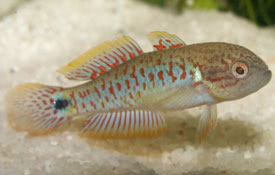
 Magyarul / Hungarian
Magyarul / Hungarian


- Scientific name: Tateurndina ocellicauda
- Common name: Peacock gudgeon
- Group: Other fishes
- Habitat: Asia; New-Guinea
- Size: 5 cm
- Biotope: Rivers, ponds and rainforest streams in schools that hover over the bottom.
- Social behavior: Peaceful
- Diet: Live or frozen foods such as Cladocerans, Mosquito larvae or Bloodworms to keep the fish in spawning condition, good quality flake and bite-size pellet foods.
- Breeding: Quite easy
- Tank: Minimum 80 litres
- Population: 4-5 fishes for 80 litres
- Decoration: For substrate use sand, and plant the tank at the edges and in the background.
- Temperature: 24-25 °C
- pH: 6,5-7,5
- Hardness: 5,6-8,4NK°
- Lifespan: 3-5 years
Description: This is a stunning fish, often mistaken for a killifish due to it's amazing coloration and pattern. The base color of the fish is a light blue, this is overlaid with bright pink/red broken vertical stripes and a large black eyespot decorates the peduncle. The fins have a large stripe of bright yellow and mature females sport black trim on the anal fin, I have seen reports of some males having this black stripe as well. The caudal fin is also edged in yellow and speckled with red. Males of the species are significantly larger then the females and when mature develop a moderate nuchal hump.
A pair of peacock gudgeons can do well in a 10 gallon tank, more then one pair is best kept in a 20 gallon. While generally a peaceful fish in temperament, males will display and chase a bit as they defend a breeding spot. This is not a reclusive species but they can be shy and take a couple weeks to adjust to new surroundings. A well decorated tank will help them feel secure.
The tank ideally should include plenty of plants and small rockwork for caves. A sand or smooth edged gravel substrate is fine. While these gudgeons are inclined to spend time near the bottom of the tank they can frequently be seen exploring in the middle strata as well. They do fine in communities of other small peaceful fish although mine have not been seen to spawn in that situation.
While many report difficulty getting these fish to eat anything but live food my tank bred specimens accept flake and small pellets quite well. They will sometimes come near the surface to take food when competing with other species but generally they prefer to feed lower in the tank.
When breeding the male needs a cave, a niche amongst rocks works well but small ceramic caves and half inch pvc pipe are better options if you intend to raise fry. The male will defend a chosen cave against other males and lure a female by displaying in front of it, when she ventures near he will nudge to encourage her to enter. Once eggs are laid he will remain in the cave fanning and guarding them until hatching. Unfortunately once they are free swimming he forgets his parental duty and will promptly eat them, as will any other fish in the tank. To save fry it's best to watch carefully and pull the cave out as soon as the eggs hatch. It can then be placed in a small tank for raising. This can also be done before hatching if you can get the male to come out. When pulling eggs be sure to situate an airstone near the cave opening to keep water movement over them.









